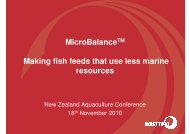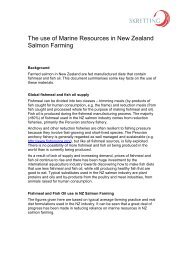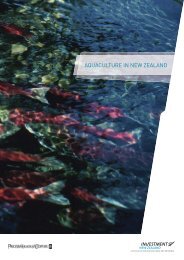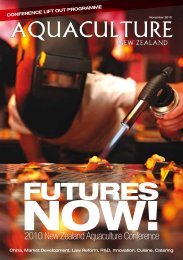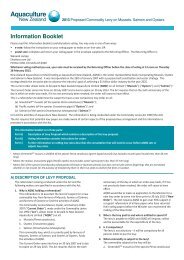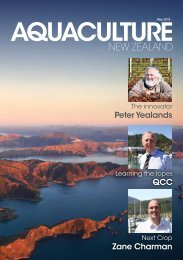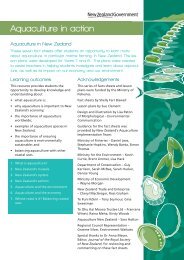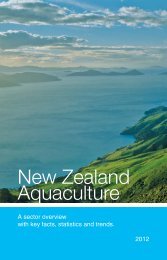March, 2011 - Aquaculture New Zealand
March, 2011 - Aquaculture New Zealand
March, 2011 - Aquaculture New Zealand
Create successful ePaper yourself
Turn your PDF publications into a flip-book with our unique Google optimized e-Paper software.
<strong>March</strong> <strong>2011</strong><br />
DNA<br />
Where will<br />
it take us<br />
PLUS: Law & order<br />
Spat NZ domesticating the Greenshell
<strong>March</strong> <strong>2011</strong><br />
PLUS: Law & order<br />
Spat NZ domesticating the Greenshell<br />
DNA<br />
Where will<br />
it take us<br />
Published by the<br />
<strong>New</strong> <strong>Zealand</strong> Seafood<br />
Industry Magazine Ltd.<br />
POSTAL ADDRESS:<br />
Private Bag 24901,<br />
Wellington 6142, NZ<br />
PHYSICAL ADDRESS:<br />
Level 1, Seafood Industry House,<br />
74 Cambridge Terrace,<br />
Wellington 6011, NZ<br />
Phone: + 64 (0)4 385 4005<br />
Fax: +64 (0)4 3852727<br />
www.seafoodnewzealand.co.nz<br />
EDITOR: Adam Hicks<br />
Email adam.hicks@aquaculture.co.nz<br />
DDI: +64 (03) 546 2662<br />
Mob: +64 (0) 21 244 5166<br />
Editorial content compiled by<br />
<strong>Aquaculture</strong> <strong>New</strong> <strong>Zealand</strong>.<br />
Design: JK Frith Design<br />
jkfrith@xtra.co.nz<br />
Level 1, Wakatu House,<br />
Montgomery Square,<br />
Nelson 7010<br />
<strong>New</strong> <strong>Zealand</strong><br />
Email: office@aquaculture.org.nz<br />
Phone: 03 548 8944<br />
Fax: 03 548 8984<br />
GENERAL:<br />
<strong>Aquaculture</strong> <strong>New</strong> <strong>Zealand</strong> is produced<br />
quarterly as a supplement to Seafood<br />
<strong>New</strong> <strong>Zealand</strong> magazine.<br />
Contributions relevant to the<br />
aquaculture industry are welcomed and<br />
industry participants are encouraged<br />
to contribute.<br />
Articles and information printed<br />
in <strong>Aquaculture</strong> <strong>New</strong> <strong>Zealand</strong> do not<br />
necessarily reflect the opinions or<br />
formal position of the <strong>New</strong> <strong>Zealand</strong><br />
Seafood Industry Council Ltd, or the<br />
industry organisation <strong>Aquaculture</strong> <strong>New</strong><br />
<strong>Zealand</strong> unless otherwise stated.<br />
All material published in <strong>Aquaculture</strong><br />
<strong>New</strong> <strong>Zealand</strong> is done so with care to<br />
ensure accuracy and factual content.<br />
However the publishers and editorial<br />
staff cannot accept responsibility for any<br />
inadvertent errors and/or omissions that<br />
may occur.<br />
So good,<br />
the heart beats<br />
stronger<br />
When it feels this good it<br />
can’t be bad for you. Right<br />
It’s something diners have long suspected<br />
about that warm glow they get after a finely<br />
cooked King Salmon meal washed down with<br />
a glass of pinot gris.<br />
And now there’s medical evidence to prove<br />
that a tipple at the table is good for you.<br />
A recent study by French researchers<br />
analysing data from 84 independent studies<br />
shows that people who regularly drink wine<br />
with a meal containing omega-three fatty acids<br />
have up to 20 per cent more heart tissue.<br />
The extra tissue makes the heart healthier<br />
and stronger and improves a person’s<br />
cardiovascular system.<br />
Get it<br />
while it’s<br />
The trend, as they say, is your<br />
friend. And for <strong>New</strong> <strong>Zealand</strong><br />
aquaculture products, the<br />
dining trends of <strong>2011</strong> are<br />
looking very chummy.<br />
While the results were only published<br />
last month in the Current Pharmaceutical<br />
Biotechnology journal, top <strong>New</strong> <strong>Zealand</strong> food<br />
scientist Grant MacDonald said the links had<br />
been known for some time.<br />
“I’ve downloaded about 400 studies along<br />
the same lines,” he said.<br />
“There’s lots of articles, and evidence that<br />
this is real.<br />
“They don’t understand it fully, but the<br />
benefits of the wine do seem to team up with<br />
omega-3s to have a greater effect.<br />
“It’s very complex. On one level, the<br />
polyphenyls in wine are antioxidants so they<br />
lower the oxidative stress on the person’s body,<br />
and so do omega-3s in that they have antiinflammatory<br />
properties.<br />
“Together, they seem to work better but they<br />
can’t put their finger on it just yet as to why.”<br />
Dr MacDonald is quick to point out that the<br />
results reflect a moderate consumption<br />
of alcohol.<br />
After working around <strong>New</strong> <strong>Zealand</strong>’s<br />
seafood industry for over thirty years,<br />
Dr MacDonald recommends King Salmon<br />
and Greenshell Mussels as good sources of<br />
omega-3s.<br />
“King Salmon is close to 25 per cent oil<br />
– it’s actually a cheap way of getting your<br />
omega-3s,” he said.<br />
“In <strong>New</strong> <strong>Zealand</strong>, King Salmon is<br />
probably the best source of fatty fish.<br />
“Per 150g of fish, there’s about 35g<br />
of lipids which will give you about 9g of<br />
polyunsaturated fatty acids – that works<br />
out to about 5 times your recommended<br />
daily intake of omega-3s.”<br />
But it’s not just found in fish.<br />
“You look at Greenshell mussels –<br />
they have a good amount of omega-3s,”<br />
Dr MacDonald said.<br />
“There’s about 1.3 grams of<br />
omega-3s per 100grams of mussels<br />
plus they’re really high in a lot of<br />
other nutrients.” • Jonny Schwass<br />
The ‘What’s Hot in <strong>2011</strong>’ chef<br />
survey by America’s National<br />
Restaurant Association serves<br />
up <strong>New</strong> <strong>Zealand</strong>’s King Salmon,<br />
Greenshell Mussels and Pacific<br />
Oysters on top of the menu for<br />
local diners.<br />
Of the top 10 ‘Hottest’ trends,<br />
five will put our products on plates<br />
in the coolest kitchens with locally<br />
sourced seafood (1), sustainability<br />
(3), Sustainable seafood (7), back<br />
to basics (9) and Farm branded<br />
ingredients (10) nominated by the<br />
1500 chefs surveyed.<br />
For Christchurch chef Jonny<br />
Schwass, proprietor of renowned<br />
Restaurant Schwass, it all comes<br />
back to a greater desire to know<br />
where our food comes from.<br />
“It makes sense for it to be an<br />
‘in’ thing,” he said.<br />
“For some reason everyone’s<br />
starting to care about where their<br />
food comes from.<br />
“For such a long time they<br />
didn’t care – they only cared what<br />
it cost.<br />
Top 10 Food Trends<br />
1 Locally sourced meats & seafood<br />
2 Locally grown produce<br />
3 Sustainability<br />
4 Nutritionally balanced<br />
children’s dishes<br />
5 Hyper-local (e.g. restaurant<br />
“Now they’ve started to care<br />
which town it comes from, who<br />
grew it, what it ate, what it’s<br />
parents ate – they want to know<br />
everything about it.<br />
“It’s a very current topic with<br />
all this stuff coming out about<br />
battery hens and pigs raised in<br />
sow crates.”<br />
Suddenly the source of a meal,<br />
has become the story behind it.<br />
“Any story that’s a true story,<br />
a genuine story that involves<br />
sustainability or integrity is a<br />
good story to tell,” he said.<br />
“Image a waiter serving cheap<br />
Canadian bacon to your table and<br />
telling you this pig suffered all<br />
its life, had welts all over its body<br />
until it died and that’s the reason<br />
it’s cheap on your plate tonight.<br />
“Compare that with if you tell<br />
them that we went out to the farm<br />
where these lambs grew, tasted<br />
the grass, went to the processing<br />
plants … that’s a good story to tell<br />
– it’s almost old fashioned.<br />
“Any good food culture<br />
revolves around buying good<br />
food from people you trust, it’s<br />
not always about convenience.<br />
We’d rather spend all day finding<br />
really good stuff and do bugger<br />
all to it.<br />
“I buy pigs from a pig farmer<br />
that we trust, we buy oysters<br />
from the Marlborough Sounds<br />
and we buy salmon from King<br />
Salmon because we know they<br />
look after them – they don’t<br />
add growth hormones or add<br />
anything to make it more than a<br />
salmon,” he said.<br />
gardens, do your own butchering)<br />
6 Children’s nutrition<br />
7 Sustainable seafood<br />
8 Gluten-free/food allergy conscious<br />
9 Simplicity/back to basics<br />
10 Farm/estate-branded ingredients<br />
While Restaurant Schwass has<br />
become known for it’s sustainable<br />
approach, Jonny is quick to point<br />
out that it’s more of a philosophy<br />
than a theme.<br />
“We care about the food we<br />
serve and we want to know where<br />
it comes from.<br />
“We want to know it hasn’t<br />
been sprayed with pesticides and<br />
herbicides.<br />
“We want food to taste like<br />
what it should – we want a carrot<br />
to taste like a carrot and a salmon<br />
to taste like salmon.” •<br />
2 m a r c h 2 0 1 1 3
A plan is hatched<br />
Picture: Dan McCall SpatNZ operations<br />
manager (left) and senior aquaculture<br />
technician Bridget Alexander (front right)<br />
and aquaculture technician Nikki Hawes.<br />
A $52 million investment to domesticate the Greenshell Mussel<br />
is about to revolutionise the industry. With selectively bred<br />
broodstock, a hatchery, new jobs and an eight-figure injection<br />
in yearly revenue, this looks set to be the biggest single<br />
development in decades.<br />
There is a buzz a-brewing through <strong>New</strong><br />
<strong>Zealand</strong>’s <strong>Aquaculture</strong> sector with news that<br />
the Greenshell Mussel will be domesticated.<br />
It’s news that’s considered the biggest<br />
single advancement in the industry in<br />
nearly 40 years.<br />
It became official last month with the<br />
announcement of Spat NZ’s successful<br />
Primary Growth Partnership bid that will<br />
see $52million dedicated to creating a<br />
brood stock and facilities to revolutionise<br />
the industry.<br />
“It’s monumental,” explains PGP<br />
steering committee chair Toni Grant.<br />
“I see this as the industry growing up.<br />
“It’s part of our evolution.<br />
“This will enable the biggest<br />
development in the industry since we<br />
started farming mussels on long lines<br />
nearly 40 years ago.”<br />
Domestication will see the sector move<br />
away from wild-caught spat, in favour of<br />
animals with pre-determined market and<br />
production desired traits.<br />
It has the potential to improve every<br />
aspect of growing, from sourcing spat,<br />
grow times, product attributes, shelf life<br />
and ultimately profit margins.<br />
Under the seven-year project, Spat<br />
NZ, a collaboration between industry<br />
heavyweights Sanford, Sealord and Wakatu<br />
Incorporation, will build a hatchery and<br />
develop the capabilities to seed a new-andimproved<br />
line of Greenshell mussels.<br />
Sanford Managing Director Eric Barratt<br />
told investors the project would emulate<br />
the selective breeding gains achieved in<br />
other primary sectors.<br />
“Selective breeding has been by far the<br />
most significant development in industries<br />
such as dairy, beef, sheep, fruit, vegetable<br />
and wine,” Mr Barratt said in his Annual<br />
Meeting address.<br />
“The <strong>New</strong> <strong>Zealand</strong> mussel<br />
industry has grown to be the<br />
largest single seafood item<br />
exported from <strong>New</strong> <strong>Zealand</strong><br />
but so far only on the basis of<br />
wild caught spat harvested<br />
from beaches north of<br />
Auckland and through spat<br />
harvested in the Golden<br />
Bay and Marlborough<br />
Sounds areas.<br />
“This seven year programme will<br />
co-develop hatchery and life-cycle breeding<br />
families to supply spat on a commercial<br />
basis to the industry in future years.<br />
“We are very confident that this<br />
programme will have significant economic<br />
value to the partners with the selectively<br />
bred mussels being able to achieve<br />
improved prices through better quality,<br />
greater yield and faster growth.”<br />
Early figures suggest the project could<br />
add up to $230 million in annual revenue<br />
and create a significant number of jobs by<br />
its completion.<br />
“When the project is completed and<br />
we look out in 2025 when we have this<br />
selectively bred spat and we know how to<br />
work with it, process it and market it, it will<br />
make a significant contribution to industry’s<br />
billion-dollar goal,” Ms Grant said.<br />
The SPAT NZ project is also significant<br />
in that it marks the first time that industry<br />
competitors have pooled resources for<br />
research and development.<br />
“Individually, each company had been<br />
doing their own research for years,” Ms<br />
Grant said.<br />
“In 2009 it all came together as there<br />
were separate projects going on with<br />
separate funding and we realised we’d be<br />
able to move forward faster by pooling our<br />
resources and sharing knowledge.” •<br />
4<br />
m a r c h 2 0 1 1 5
After decades of pioneering<br />
research, industries accept<br />
genome sequencing is:<br />
Real<br />
science,<br />
no fiction<br />
Dr Peter Ritchie<br />
Twenty-one years ago, sequencing<br />
an entire genome was the stuff<br />
of science fiction. Today it is the<br />
cornerstone of production gains<br />
for <strong>New</strong> <strong>Zealand</strong>’s, and the world’s,<br />
largest primary industries.<br />
Think of it as reading the blue<br />
print of an animal - this gene’s for<br />
colour, that gene’s for growth rate<br />
and this gene’s for taste.<br />
As one of the country’s leading<br />
experts in the field, Victoria<br />
University’s senior lecturer in genetics<br />
Peter Ritchie explains, many industries<br />
now use an animal’s DNA sequence to<br />
produce the perfect product.<br />
“Whole-genome analysis can<br />
pinpoint small genetic differences<br />
associated with important<br />
production traits, and we can then<br />
design precision mating and animal<br />
management systems and fast-track<br />
ways to identify superior animals for<br />
breeding,” Dr Ritchie said.<br />
“We get quicker genetic gains<br />
across a broader range of traits<br />
and we have the flexibility to select<br />
animals for specific situations.”<br />
The NZ dairy and beef industries<br />
have been benefiting from the<br />
technology for years but according to<br />
Dr Ritchie, it’s the aquaculture sector<br />
that has the most to gain.<br />
“The dairy industry has a large<br />
genomics focus and the cattle<br />
industry also has a value driven<br />
genetics programme - all of those<br />
primary industries can see that this<br />
is transformational technology,” Dr<br />
Ritchie said.<br />
“If you asked anyone in<br />
dairy, they’d say whole genome<br />
selection techniques are going to<br />
be responsible for 70 per cent of all<br />
future production increases.<br />
“If we have a long term focus,<br />
there’s no reason we can’t get<br />
those sorts of numbers with the<br />
Greenshell mussel.<br />
“<strong>Aquaculture</strong> doesn’t have the history<br />
of thousands of years of domestication<br />
that’s already resulted in a series of<br />
incremental production gains.<br />
“…we could<br />
effectively<br />
skip what<br />
took<br />
hundreds<br />
of years of<br />
selective<br />
breeding to<br />
achieve in<br />
land-based<br />
agriculture.”<br />
“We’re starting from scratch so<br />
we’ve got a lot more to gain.<br />
“With <strong>Aquaculture</strong>, we could<br />
effectively skip what took hundreds<br />
of years of selective breeding to<br />
achieve in land-based agriculture.<br />
“Developing genomic<br />
technologies for aquaculture species<br />
would effectively turbo charge<br />
things and get some rapid progress.”<br />
When Dr Ritchie first started<br />
working in the field in 1990, genetics<br />
made world wide headlines with<br />
plans for the Human Genome Project.<br />
“We had just developed gene<br />
sequencing technology and they<br />
started talking about mapping the<br />
human genome,” he said.<br />
“Some people thought it was crazy.<br />
“They said ‘why would we want<br />
to do that’.”<br />
The project took 13 years to<br />
complete and is estimated to have<br />
cost $3billion.<br />
As well as transforming our<br />
knowledge of the human body, it also<br />
revolutionised the field of genetics<br />
and made the technology a lot more<br />
accessible.<br />
With today’s technology Dr Ritchie<br />
estimates <strong>New</strong> <strong>Zealand</strong> could sequence<br />
the Greenshell Mussel genome in<br />
around six months at a cost of about<br />
$700,000. We’d then be in a position<br />
Some facts<br />
about DNA:<br />
• DNA is short for:<br />
Deoxyribonucleic acid<br />
• The first dog to have<br />
it’s genome sequenced<br />
was a standard poodle<br />
named Shadow<br />
• The Beijing Genomics<br />
Institute is leading<br />
an international<br />
collaboration to<br />
sequence 1000 animal<br />
and plant genomes of<br />
economic and scientific<br />
importance over the<br />
next two years<br />
• The list of species<br />
sequenced is constantly<br />
growing. So far it<br />
includes:<br />
- Strawberries<br />
- Bed bugs<br />
- The wooly<br />
mammoth<br />
- Rice<br />
- Cows<br />
- Humans<br />
- Japanese<br />
pufferfish<br />
to develop whole-genome selective<br />
breeding programs and efficiently pick<br />
the best natural products.<br />
“As the saying goes, yesterday’s<br />
science fiction is today’s reality,” he said.<br />
“This is not about predicting future<br />
trends, this is about keeping up.<br />
“As a geneticist I am really<br />
positive about the potential for<br />
gains in aquaculture. Compared<br />
to land-based production animals,<br />
marine species have very large<br />
population sizes, which means they<br />
hold a very large amount of genetic<br />
potential. We just need the right<br />
tools to unlock it.<br />
“But industry and science and<br />
government are going to have to make<br />
a decision about whether to invest<br />
and how to coordinate the resources<br />
to do it. It will take more than just me<br />
– we will need a team of researchers.<br />
“It would require some solid<br />
R&D investment and coordinating<br />
a specific set of <strong>New</strong> <strong>Zealand</strong>’s<br />
science resources.<br />
“We need to get scientists and<br />
industry to sit around the table, get<br />
a plan together and start working<br />
towards that plan.<br />
“It will take industry, university<br />
and CRI involvement to build<br />
something great over the long term<br />
and I believe we can do that. •<br />
6<br />
m a r c h 2 0 1 1 7
As one of the<br />
authors of the<br />
<strong>Aquaculture</strong><br />
Strategy, Mike<br />
Burrell, officially<br />
put law reform<br />
on the sector’s<br />
agenda. As<br />
chief executive<br />
of <strong>Aquaculture</strong><br />
<strong>New</strong> <strong>Zealand</strong>, he<br />
has worked for<br />
change for four<br />
years. Now, as he<br />
prepares to present<br />
the organisation’s<br />
submission on<br />
the <strong>Aquaculture</strong><br />
Amendment Bill<br />
(No.3), we asked<br />
Mike about the<br />
sector’s…<br />
Law&<br />
order<br />
Q<strong>New</strong> <strong>Zealand</strong>’s aquaculture sector has<br />
wanted legislative reform for a decade – is<br />
this Bill worth the wait<br />
We’ll know when it’s an Act. It’s getting<br />
towards what we need but there’s still some<br />
major things that need to be improved,<br />
particularly around renewal provisions<br />
of coastal permits and the detail of how<br />
planning and consenting will work in<br />
practice.<br />
QSubmissions on the bill closed last<br />
month – how important was it for<br />
AQNZ to make a submission<br />
It’s extremely important. What we learned<br />
from the 2004 reforms is that the detail of<br />
legislation matters enormously, even when<br />
industry and government want the same<br />
thing – sustainable economic growth. We<br />
got it wrong in 2004 and to the great cost of<br />
industry and <strong>New</strong> <strong>Zealand</strong>. We can’t afford<br />
to get it wrong this time, which is why we’ve<br />
been involved at a strategic level from the<br />
beginning. We made submissions on the<br />
TAG report, and on the cabinet decisions<br />
so it was very important that we followed<br />
through at this crucial stage to ensure that<br />
the Bill is as good as it could possibly be.<br />
QWhat are the biggest gains for the sector<br />
from the Bill<br />
This is a major piece of reform. We fully<br />
support the active role for central government<br />
contained within the Bill. We support giving<br />
the Minister of <strong>Aquaculture</strong> powers to make<br />
changes to regional coastal plans. Our hope<br />
is that regional councils will take the initiative<br />
and provide for the sustainable growth of<br />
aquaculture. But we do think it is important<br />
that where the government sees national<br />
priority, that they have the tools to be able to<br />
make it a reality. We support changes to the<br />
Waikato and Tasman regional plans to increase<br />
flexibility. A significant amount of future<br />
growth will come from using the same water<br />
we use now, but for higher value purposes. We<br />
are very supportive of a minimum period for<br />
aquaculture consents. If you want to attract<br />
investment, you need to provide certainty<br />
for that investment. Our preference is for the<br />
default for a coastal permit to be a 35-year<br />
minimum period.<br />
We support attempts to align the UAE and<br />
RMA processes and increase the flexibility<br />
for applicants. We think more can be done<br />
in this area and we’ve made this point in our<br />
submission but this is certainly a step in the<br />
right direction.<br />
We support provisions to allow for the<br />
processing of frozen applications - these are<br />
the applications that were put on hold in the<br />
lead up to 2004 reforms and remain frozen<br />
to this day.<br />
And we are very supportive of the crown<br />
accepting responsibility for meeting the<br />
commitment to the Maori Commercial<br />
<strong>Aquaculture</strong> Claims Settlement Act. We<br />
have recommended that government work<br />
with iwi to develop a methodology to deliver<br />
the settlement to the satisfaction of all iwi.<br />
QCan this bill enable industry to reach it’s<br />
billion-dollar target<br />
We say at beginning of our submission that<br />
with significant improvements it can deliver<br />
sustained and sustainable growth. Those<br />
improvements are the 47 recommendations<br />
in our submission. But without them, we<br />
fear the <strong>2011</strong> reforms will be a repeat of 2004<br />
and we’ll see a levelling off of growth around<br />
2015. If that happens, it’ll leave us well short<br />
of the billion dollar goal and return us to the<br />
doldrums of the lost decade. But if changes<br />
are made we’re confident the Bill, along<br />
with research and development, marketled<br />
innovation and investment in skills and<br />
education, will deliver the billion-dollar<br />
target by 2025.<br />
QHow close did government work with<br />
<strong>Aquaculture</strong> <strong>New</strong> <strong>Zealand</strong> in developing<br />
this bill<br />
From the beginning we’ve worked with<br />
government, councils and iwi, through<br />
the aquaculture CEO forum to ensure<br />
these reforms were going to work from a<br />
commercial point of view and we’ve been<br />
very pleased with how the government<br />
has listened and provided us with the<br />
opportunity to have our say. That’s not to say<br />
we agree with everything they’ve decided.<br />
But it’s an extremely good process for<br />
industry to have.<br />
QDissecting the intricacies of a piece of<br />
draft legislation with consideration to<br />
the common and varying interests of industry<br />
participants is no doubt a major piece of work.<br />
How did you go about preparing the submission<br />
We drew on as much expertise as<br />
possible from within the industry – from<br />
the companies who’ve been through it<br />
before and know better than anyone what<br />
works and what doesn’t. We used the<br />
expertise of the AQNZ board and we drew<br />
on the expertise of the Marine Farming<br />
Association, the Coromandel Marine<br />
Farmers Association, the <strong>New</strong> <strong>Zealand</strong><br />
Oyster Industry Association and the<br />
Salmon Farmers Association. We also<br />
held two workshops for all stakeholders<br />
to provide feedback on the Bill which<br />
we incorporated into our submission.<br />
Where we could not reach agreement,<br />
this was reflected in the submission and<br />
left to individual companies to make their<br />
points of view known to the committee.<br />
But for the main part, there was a very<br />
strong consensus of support around our<br />
submission and that gives it a lot of strength.<br />
QWhen <strong>Aquaculture</strong> <strong>New</strong> <strong>Zealand</strong><br />
was established in 2007, one of the<br />
organisation’s key goals was to advocate for<br />
legislative change – do you consider this bill<br />
to be the realisation of that goal<br />
Ask me that question again in a year. We<br />
won’t consider that we’ve met this goal until<br />
the Act has been passed and signed into law<br />
and until we see how it works in practice.<br />
What that means is we’ll be working hard<br />
with industry and the government to ensure<br />
a smooth implementation which gives<br />
effect to the objectives of the bill as quickly<br />
as possible. •<br />
m a r c h 2 0 1 1 9
Scientist. Author. Promoter.<br />
The original authority on<br />
Greenshell Mussel Powder,<br />
he has travelled the world for<br />
more than 30 years spreading<br />
his message about arthritic<br />
relief from the sea. Now...<br />
Heeere’s<br />
Johnny...<br />
It’s 1980 and John Croft is readying himself to appear on the<br />
Tonight Show starring Johnny Carson.<br />
Nearing the end of a American-wide tour promoting<br />
McFarlane’s Greenshell mussel powder, Mr Croft was set to<br />
join an illustrious list of guests, including Muhammad Ali<br />
and the Jackson Five, to have appeared on television screens<br />
alongside the man known as the King of Late Night.<br />
But before he got to hear that famous line ‘Heeere’s Johnny’,<br />
the phone rang.<br />
“I was in the hotel room ready to go on and got a call from<br />
the McFarlane’s company lawyer,” he said.<br />
“He said you’d better get yourself out of San Francisco – the<br />
FDA (Food and Drug Administration) will be looking for you.”<br />
When it comes to the therapeutic benefits of the Greenshell<br />
Mussel, Mr Croft wrote the book on it.<br />
Literally.<br />
His title, Natural relief from arthritis – a Safe and<br />
Effective Treatment from the Ocean, was published in 1979<br />
and prompted the speaking and promotional tour of<br />
the USA.<br />
Mr Croft appeared all over the country carefully<br />
promoting the general health benefits of mussels<br />
but before he made it onto the Johnny Carson<br />
show, a generic Greenshell mussel advertising<br />
campaign had upset authorities by claiming<br />
<strong>New</strong> <strong>Zealand</strong> mussels to be an arthritis cure.<br />
The FDA reacted strongly to the claims.<br />
“Our people didn’t want me arrested,<br />
they said get yourself out of there,”<br />
he said.<br />
“I went straight to the airport<br />
and was out of there that night.<br />
“In the end I couldn’t go on the show because I had to<br />
get out of the States.”<br />
The FDA subsequently banned the import of mussel<br />
extracts in what was a huge blow to the industry.<br />
“It was sad, because it had just really taken off,”<br />
Mr Croft said.<br />
“It was a major set back to the growth of the product.”<br />
The ban was eventually overturned and today<br />
America is one of world’s largest buyers of Freeze Dried<br />
Mussel Powder with market demand growing each year.<br />
According to the latest Seafood Industry Council<br />
export statistics, <strong>New</strong> <strong>Zealand</strong> exported 298 tonnes of<br />
Freeze Dried Mussel Powder, to an approximate value of<br />
$14.5M in the year ending December 10.<br />
While growth has been continual, the reasons for<br />
demand have changed.<br />
“At first it was a novel thing, that the sea was being<br />
farmed to produce a nutraceutical,” he said.<br />
“For mussels,<br />
oysters,<br />
seaweeds,<br />
other species<br />
of fish, possibly<br />
even sea<br />
horses – there<br />
are wonderful<br />
opportunities<br />
for marine<br />
farmers.”<br />
Top LEFT: John Croft working in<br />
the original McFarlane’s laboratory<br />
(pictured below)<br />
Above: John Croft outside a Dunedin<br />
bookstore as part of a promotional<br />
tour of his 1979 title Natural relief<br />
from arthritis – a safe and effective<br />
treatment from the Ocean.<br />
Below LEFT: One of the original<br />
mussel power labels to be exported<br />
from <strong>New</strong> <strong>Zealand</strong>.<br />
“But now days, it’s topical because the latest findings<br />
on some extracts are amazing – they’re doing some<br />
things that pharmaceuticals can’t do.<br />
“There is one extract, made only by Vitaco called<br />
Seatone, which will actually inhibit the specific enzymes<br />
that denature the joint matrix and cartilage,” said Mr<br />
Croft who works as a consultant for various international<br />
companies, including Vitaco Health (NZ) Ltd.<br />
And after 30 years in the business, Mr Croft believes<br />
there is still plenty of upside for marine farmers.<br />
“The potential is enormous,” he said.<br />
“<strong>New</strong> <strong>Zealand</strong> is an ideal place for aquaculture - it’s<br />
north-south orientated, has a variety of waters, is very<br />
rich nutritionally, and has a long coast line suitable for<br />
farming a variety of species.<br />
“For mussels, oysters, seaweeds, other species of<br />
fish, possibly even sea horses – there are wonderful<br />
opportunities for marine farmers.” •<br />
10<br />
m a r c h 2 0 1 1 11



